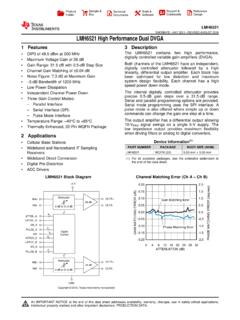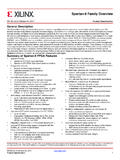Transcription of T4 DNA Ligase (Rapid) - Enzymatics
1 Product Information Sheet L6030-HC-L Rev F. Product Specification Storage Temperature -25 C to -15 C. TEST: SPECIFICATION: Purity (SDS-PAGE) >99%. Product Information Specific Activity 300,000 U/mg T4 DNA Ligase (Rapid) SS Exonuclease 6,000 U < released Part Number L6030-HC-L DS Exonuclease 6,000 U < released Concentration 600,000 U/mL DS Endonuclease 6,000 U = no conversion Unit Size 240,000 U DNA Contamination 6,000 U < 10 copies Product Description: Unit Definition T4 DNA Ligase catalyzes the formation of a phosphodiester 1 unit is defined as the amount of DNA Ligase required to bond between the terminal 5 phosphate and a 3 hydroxyl join 50% of 100 ng of DNA fragments with cohesive termini groups of duplex DNA or RNA.
2 The enzyme efficiently joins in 50 l 1X DNA Ligase Buffer following a 30 minute blunt and cohesive ends and repairs single stranded nicks in incubation at 23 C. duplex DNA, RNA or DNA/RNA hybrids (1). Source of Protein Quality Control Analysis: A recombinant E. coli strain carrying the cloned T4 DNA Unit Characterization Assay Ligase gene. Unit activity was measured using a 2-fold serial dilution method. Dilutions of enzyme were made in 1X DNA Ligase Supplied in Reaction Buffer and added to 20 L reactions containing 10 mM Tris-HCl double stranded DNA fragments and 1X DNA Ligase Reaction 50 mM KCl Buffer.
3 Reactions are incubated for 30 minutes at ~23 C, 1 mM DTT stopped, and analyzed on a 1% agarose gel stained with mM EDTA ethidium bromide. 50% glycerol pH @ 25 C. Protein Concentration (OD280) Measurement Supplied with A L sample of enzyme was analyzed at OD280 using a B1010 (2X Rapid Ligation Buffer) Nanodrop ND-1000 spectrophotometer standardized using a B6030 (10X T4 DNA Ligase Buffer) mg/ml BSA sample (Pierce Cat #23209) and blanked with product storage solution. The observed average measurement 2X Rapid Ligation Buffer (B1010): of 3 replicate samples was converted to mg/mL using an 132mM Tris-HCI extinction coefficient of 54,050 and molecular weight of 55,292.
4 20 mM MgCl2 Daltons. 2 mM DTT. 2 mM ATP SDS-Page (Physical Purity Assessment). 15% PEG 6000 L of concentrated enzyme solution was loaded on a pH @ 25 C denaturing 4-20% Tris-Glycine SDS-PAGE gel flanked by a broad-range MW marker and L of a 1:100 dilution of the 10X T4 DNA Ligase Buffer (B6030): same enzyme species. Following electrophoresis, the gel 500mM Tris-HCI was stained and the samples compared to determine 100 mM MgCl2 physical purity. The acceptance criteria for this test requires 50 mM DTT that the aggregate mass of contaminant bands in the 10 mM ATP concentrated sample do not exceed the mass of the protein pH @ 25 of interest band in the dilute sample, confirming greater than 99% purity of the concentrated sample.
5 (additional information on reverse side). Contamination Tests: For problematic ligations or if the DNA concentration is Single-Stranded Exonuclease Activity unknown, it may be necessary to vary ratios and run multiple A 50 L reaction containing 10,000 cpm of a radiolabeled ligations. single-stranded DNA substrate and 10 L of enzyme solution incubated for 4 hours at 37 C resulted in less than The presence of PEG at a high concentration will significantly release of TCA-soluble counts. reduce the transformation efficiency of electrocompetent cells.
6 In order to maximize the efficiency of transformation into electrocompetent cells, the following approaches are Double-Stranded Exonuclease Activity recommended: A 50 l reaction containing 5,000 cpm of a radiolabeled Best: Following ligation, purify the product using a DNA. double-stranded DNA substrate and 10 L of enzyme purification spin column and elute in 50 L of TE. The DNA. solution incubated for 4 hours at 37 C resulted in less than is now ready for transformation. The final amount of DNA. release of TCA-soluble counts. to be transformed should be in the range of ng.
7 Better: Dilute ligation product in ddH20 or TE to reduce the Double-Stranded Endonuclease Activity PEG concentration. The final amount of DNA to be A 50 L reaction containing g of pENZuC DNA and 10 L transformed should be in the range of ng. of enzyme solution incubated for 4 hours at 37 C resulted in no visually discernible conversion to nicked circular DNA as Enzymatics ' high-concentration T4 DNA Ligase in determined by agarose gel electrophoresis. combination with the 2X Rapid Ligation buffer greatly stimulates the rate and efficiency blunt-end ligation, 16S rDNA Contamination Test therefore long incubations (>10 minutes) are NOT.
8 Replicate 5 L samples of enzyme solution were denatured recommended and can greatly reduce the transformation and screened in a TaqMan qPCR assay for the presence of efficiency of ligation products. In order to maximize contaminating genomic DNA using oligonucleotide transformation efficiency of the correct insert/vector primers corresponding to the 16S rRNA locus. The combination, the following protocol is recommended. acceptance criterion for the test is the threshold cycle count (Ct) produced by the average of 3 replicate no template Enzymatics 10X T4 DNA Ligase Buffer does not contain PEG.
9 Control samples. Based on the correlation between the no and is compatible with standard ligation protocols which do template control Ct values and standard curve data, the not specify the use of a rapid/fast/quick format buffer. detection limit of this assay is <10 copies genome/sample. Usage Instructions (Rapid Ligation): Notes: Reaction Set-Up: One Enzymatics T4 DNA Ligase cohesive end unit is Amount Description Final Concentration equivalent to approximately 3 cohesive end units as 10 L 2X Rapid Ligation Buffer 1X. measured with a Lambda-Hind III DNA fragment substrate in X L Vector 1-10 ng/ L.
10 1X T4 DNA Ligase reaction buffer. X L Insert 1-10 ng/ L. 1 L T4 DNA Ligase (600 U/ L) 30 U/ L. One Weiss Unit is approximately equivalent to 22. X L Type I Water N/A. Enzymatics cohesive end units. 20 L Total Volume 1. Add all of above components to a clean reaction vessel, mix well T4 DNA Ligase is ATP dependent. It is recommended that the by pipetting. reaction buffer be discarded after one year of storage at - 2. Incubate at 25 C for 10 minutes. 20 C and replaced with fresh buffer to ensure maximum 3. Immediately purify DNA using PCR clean-up column and elute in performance.







